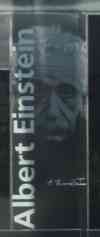
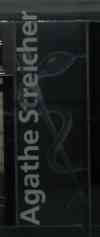
| Path: Eric's Site / Eric / Travel / Germany / Visits / Alex in Germany | Related: Germany, Journal, Visits (Site Map) |
 |
 |
| Straßenbahn customizations. | |
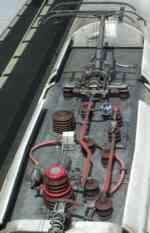 |
| ICE pantograph and electrical equipment. |
You already know from my earlier journal entries most of what is in
Ulm, so there is not much new to report. We visited the model train
stores in town.
One new sight for me was a trip to the Wiblingen monastery.
 |
| Plumber sparrow. |
 |
| Streetcar museum sign. |
Before going back, we walked a few blocks to the Porsche museum, next to the factory. On the way to the Porsche museum, some folks in a car pulled over and asked me directions. I could not help them. You have got to give me at least a few hours in a city first.
There is not much at the Porsche museum—some cars on display, a few parts, some history of the company, and trinkets to buy. There is nothing about the engineering or manufacture of the cars.
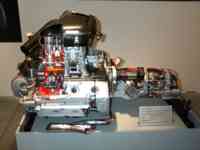 |
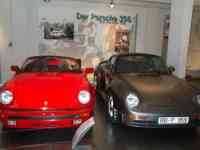 |
 |
| Porsche engine. | Two Porsche 356s. | Porsche 911. |
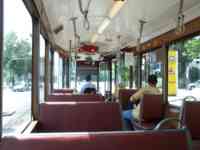 |
| Historic Straßenbahn. |
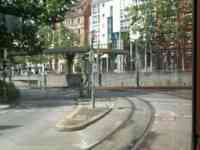 |
| A Stuttgart street. |
A random Stuttgart street we saw from the historic Straßenbahn is shown to the right.
We rode the historic Straßenbahn to the Hauptbahnhof
and then took an S-Bahn to the Daimler stadium stop. From
there, we walked around the stadium and sports fields to a place where a
shuttle takes you to the Mercedes-Benz museum. It is a fairly long walk to
the shuttle stop, so I do not know why the shuttle does not pick people up
at the S-Bahn stop. I suppose many people arrive by car, unlike
most other places in Europe.
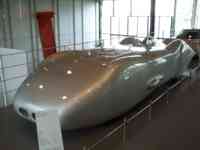 |
| Mercedes-Benz Type W 125. |
The car shown here was made in 1938. Rudolf Caracciola drove it on the Autobahn between Frankfurt and Darmstadt and reached 432.7 kilometers per hour, the highest speed ever reached on a public highway. Can you imagine you're moving along at whatever the usual speed was in 1938, and somebody comes up behind you at 432.7 kilometers per hour (268.9 miles per hour)?
We finished the Mercedes-Benz museum, took the shuttle, walked to the
S-Bahn station, and just missed a train. The next one was in half
an hour, and there were no U-Bahn stations quickly accessible.
One was nearby just across the tracks, but there was no nearby passage
or crossing to it. So we waited.
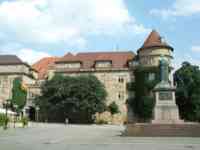 |
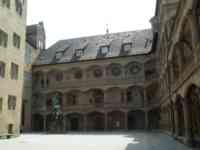 |
| Altes Schloß and statue of poet Friedrich Schiller. | Altes Schloß courtyard and statue of Württemberg's first duke, Eberhard. |
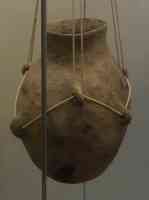 |
| 7000-year-old urn. |
The museum covers the history of people in this area. They have some ancient artifacts that appear to be whole, such as this 7000-year-old urn. There is a map that shows dots where artifacts have been recovered in the region, and it is dotted all over—people have been living here, and leaving their stuff, for a long time. Then the Romans came and ordered everybody around for a while. The museum has some sculptures and art from that time (around 2000 years ago), including mummy portraits.
The portraits show people with nearly correct perspective, which makes
me wonder why the portraits in the Ulmer Museum are flat. The Ulmer Museum
displays portraits of various guild members in town several hundred years
ago. Except for the more recent paintings, the Ulmers are shown flat,
without correct perspective, which looks naïve. The mummy portraits
show that correct perspective was known, and known in this region, 2000
years ago. So why were much later paintings done so amateurishly?
Did they lose the knowledge for a while?
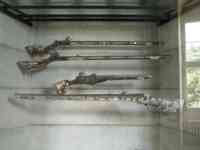 |
 |
| Rifles and pistols from 1500s and 1600s. | |
Another room in the castle museum contains a dead king, a dead queen,
two dead dukes, and a dead duchess. They died between 1875 and 1912 and
were put into sarcophagi.
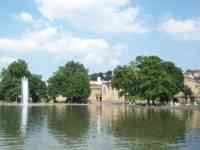 |
| Schloßgarten. |
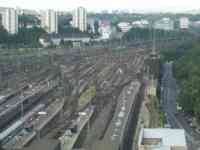 |
| Train tracks approaching Hauptbahnhof. |
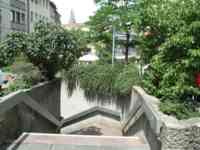 |
| U-Bahn access. |
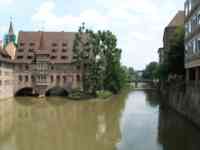 |
| Pegnitz River. |
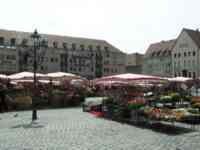 |
| Hauptmarkt. |
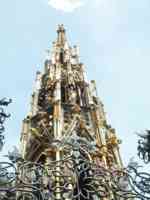 |
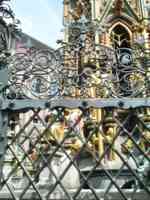 |
| Schöner Brunnen. | Golden ring. |
The walk goes north through the old city, pointing out this and that,
including a four-story-deep warren dug in the 14th century
to house a brewery and beer cellar and another bunker where the city's
art treasures were sheltered during the war. Both were closed. A little
farther north is the Imperial Castle. Pictures from that are below.
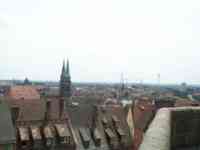 |
| Nürnberg from castle. |
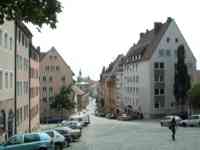 |
| Nürnberg near castle. |
After the castle, the walking tour backtracks south. There are photographs
from and near the castle on the right and below.
 |
| Good place to get cooties. |
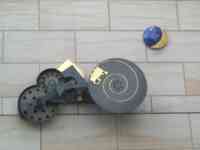 |
| Toy Museum art. |
Then the walking tour goes to an island in the Pegnitz, and the guide book
says it is a particularly scenic part of the river, but I think our first
crossing was prettier.
 |
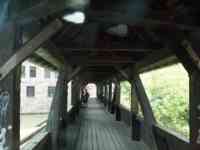 |
| Pegnitz River. | Covered bridge. |
After walking around Nürnberg, we were hungry and thirsty and ate again in the Hauptbahnhof while waiting for a train out. Several of the fast-food stores in the Nürnberg Hauptbahnhof have large, cold drinks at reasonable prices (for Europe). If you're in Germany and thirsty after a long day of walking in the heat, I recommend going to the Nürnberg Hauptbahnhof.
The first train dropped us in Treuchtlingen, where we learned the
second train was not going to show up. I did not follow the German
announcements well enough to find out why but did get enough to
figure out we were supposed to wait for something else, and all
the other passengers on that platform were waiting around too. The
station attendant asked various people were they were going and counted
them, and then she made some phone calls. She arranged for a couple of
Intercity trains that normally do not stop in Treuchtlingen to stop
there. Some of the other passengers asked, in German, if their tickets
would be good, including one person who asked about a Bayern-Ticket, and
the attendant said the tickets would be good. So, we got to use a local-train
Bayern-Ticket on an Intercity train.
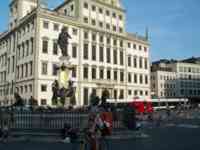 |
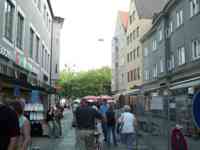 |
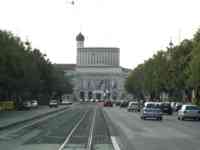 |
| A little of everything. | A shopping street. | Some building. |
First, I will say that if you were passing through Füssen on your way somewhere, stopping to see Neuschwanstein would be worthwhile. However, Füssen is not on the way to anywhere. It is the end of the line, literally. The castle tour is okay, but it is not worth the six or more hours it takes on a train to get there from Ulm and back. (From München, the round-trip can be only four hours.) I think the castle may look better in the best picture I took than it actually looked when I took the picture, so you do not really need to be there to see it. That leaves the only reason to go is to say you have been. Several sources told me Neuschwanstein was the castle to see. However, Heidelberg Castle was fine and had more stories about it, and Heidelberg is more fun. So I think nobody's life will be lacking anything if they skip Neuschwanstein. If you want to consider it, here is some information.
For the benefit of those who do go to Neuschwanstein, here are quick
directions.
|
Deutsche Bahn's computer gave me a route to Füssen that takes three hours, but the schedule left only four minutes between trains. Since trains have been late with some frequency and a missed transfer could ruin the day, I asked the web server for another route that allowed at least 15 minutes between trains. It gave me one that took four hours.
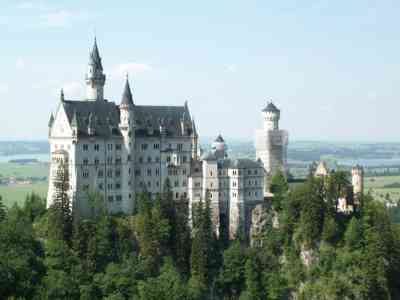 |
| Schloß Neuschwanstein. |
The poor attendant is obviously tired of answering questions about this. There is a sign saying he does not give change or tourist information. That shows they know people want change and tourist information. The sign does not solve that problem; it is just a roadblock.
(Why does the bus number have four digits? I doubt there are enough routes there to require even two digits.)
The bus takes people to the adjacent town, Hohenschwangau, and lets them off next to a tourist information center. Again, almost every person getting off the bus is going to the castles, but they have not put up a sign that says, "Hey, you folks going to the castles, first pick up your tickets at the ticket center, which is left, around the corner to the right, and up the street." Actually, it is perfectly obvious once you see it and must be blindingly obvious to residents, but tourists cannot see through trees and buildings, so they do not know. There are lots of signs, and the information may be there, but it does not make sense until you already understand or study for a while. One big sign, that's all they need.
Two days before our trip, I ordered tickets for both castles. Preordering is recommended to avoid a long wait, and that was necessary since Alex and I were trying to fit the journey there and back into a single day, leaving us not a great deal of time in the Füssen area. The email I got back from the ticket center and the signs when we got there made the operators seem very inflexible, but they were flexible about giving us earlier tickets, so that worked out well.
Even so, everything about the castle tours is set up for the convenience of the operators, not the tourists. You get there on your own, via public transit or private tour. The ticket center is located at the bottom of the hills and you must buy tickets there, guessing how long it will take you to traverse unfamiliar terrain. The English tour of Hohenschwangau Castle is via audio player, so it is low labor for the operators. And so on. It feels more like a Disneyland thing than a historic site.
We picked up our tickets, got some food, and waited for the Hohenschwangau Castle tour.
Photographs inside are not permitted inside the castles. I do not know why. I think more people would be inspired to come by photographs than would be deterred. So all I have to show you is outdoor photographs.
The Hohenschwangau Castle tour is sterile. They show you the usual artifacts of wealth and royalty, and that's about it. One item of interest is an original loaf of gift bread for the prince regent's 70th birthday in 1891. If you go, I recommend skipping the Hohenschwangau Castle tour and buying only tickets for Neuschwanstein Castle.
From Hohenschwangau, we walked up to Neuschwanstein Castle. If you make this trip, buy beverages at the bottom. Most of the way up, where people with a sedentary lifestyle are fatigued and may be thirsty and suffering in the heat, there is a concession stand that sells 0.3 liters of soda for €2.20. That may be the highest price I have seen.
We arrived with time to spare and went to see the nearby bridge and waterfall. Pictures are below, in a group with the others from the day.
The Neuschwanstein tour is better, although I think they would do well to hire a good dramatic writer to do some research and design an entertaining tour. The throne room (which never had a throne because King Ludwig II died shortly after the castle was partially ready) has a 2000-pound crown-shaped chandelier and a mosaic floor made of about a million tiles. Another room is made, with plaster, to look like a cave out of a Wagner opera. The room is well done; the cave is reasonably convincing.
Neuschwanstein means "new swan stone." The castle is new because it replaced a Middle Ages castle that was on the same site and was destroyed to build Neuschwanstein. The castle has a swan theme because Ludwig II was fond of swans.
I did not get a great sense of being in a castle while I was actually inside the castles. Sure, the rooms are large and connect to other large rooms and have expensive things, but they could be rooms in a modern palace or even a fancy hotel.
Another example of how everything is arranged for the tour operators is the gift shops on the way out. Of course, a gift shop at the exit is obligatory at every major attraction in the world, but Neuschwanstein Castle has two, and you must pass through each separately to get out. I bought a nice mousepad in one of them.
Pictures from our day at the castles follow.
The bridge (Marienbrücke) looks quite far from the castles in the photographs, but it is only an eight-minute walk, if you can get up a steep paved hill without trouble.
On the way out of Füssen, we stopped by a small bakery in the foyer
of a grocery store near the train station. They had a good almond pastry
with a dab of fruit purée. Then we got on the train for the
three-hour trip back to Ulm.
| Path: Eric's Site / Eric / Travel / Germany / Visits / Alex in Germany | Related: Germany, Journal, Visits (Site Map) |
© Copyright 2003 by Eric Postpischil.